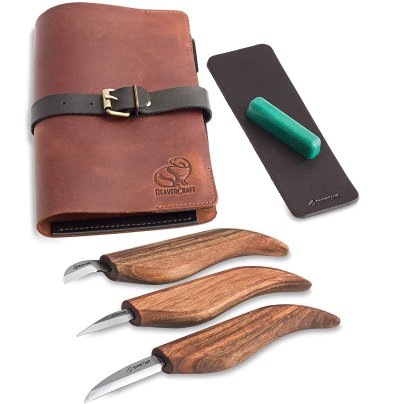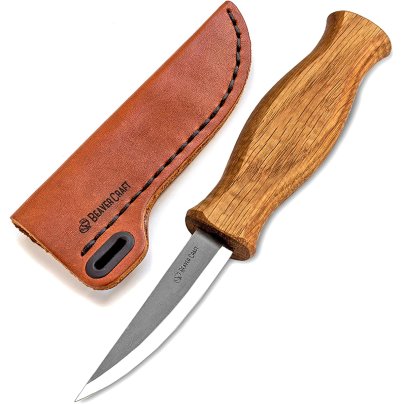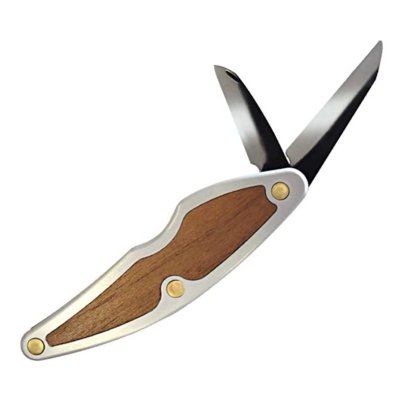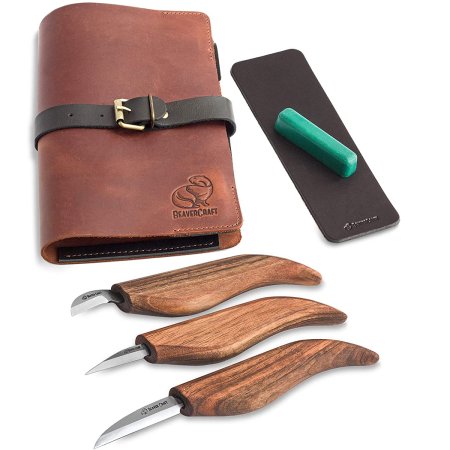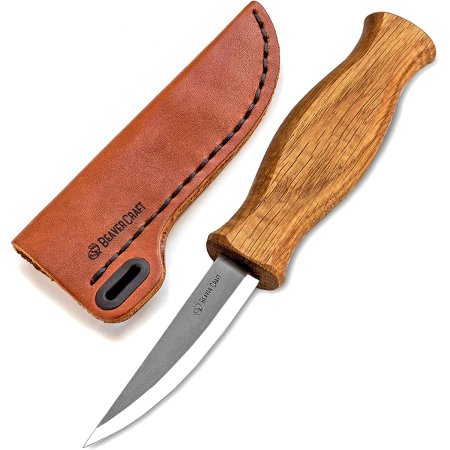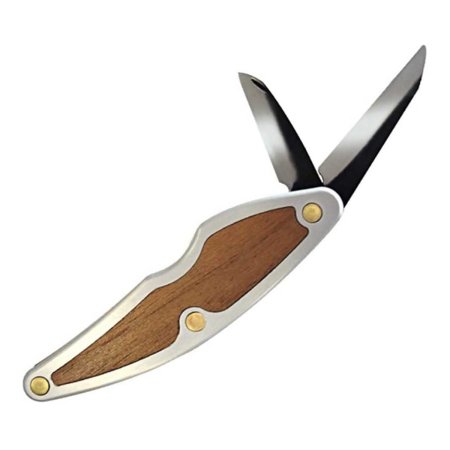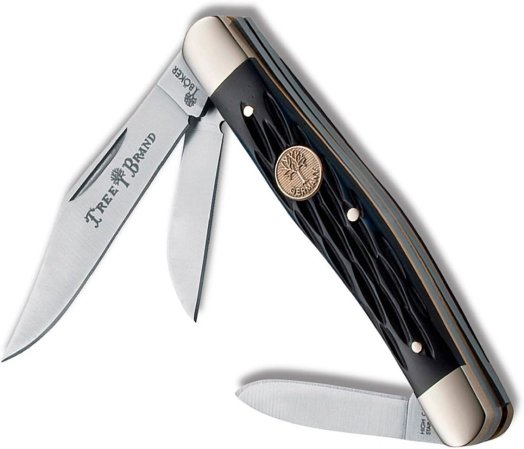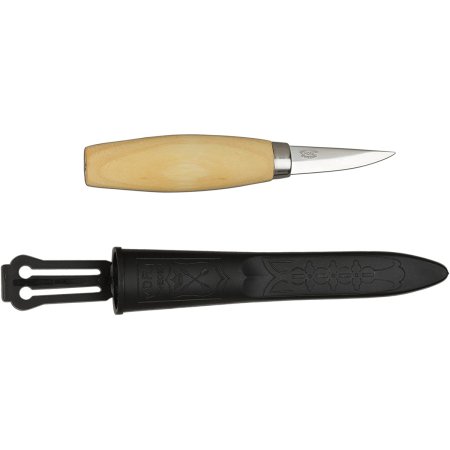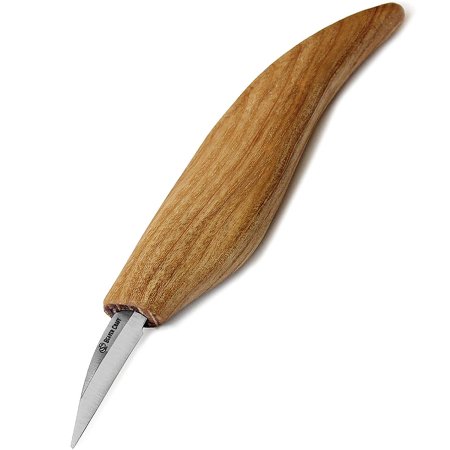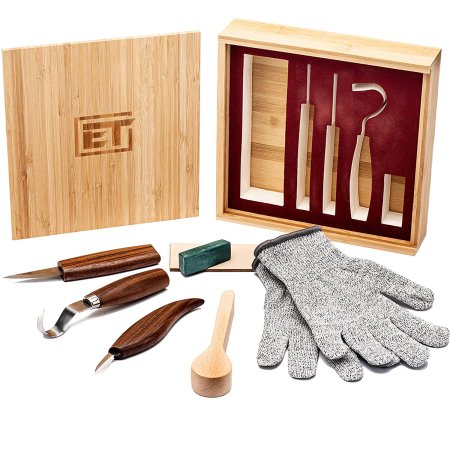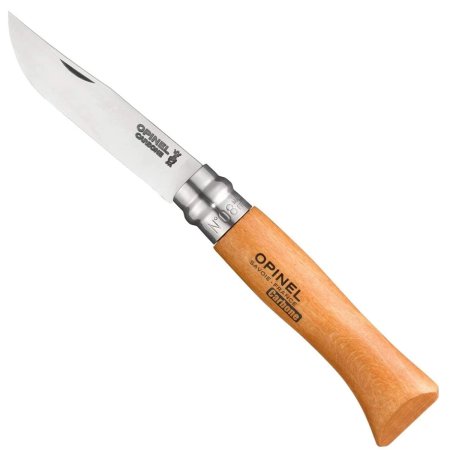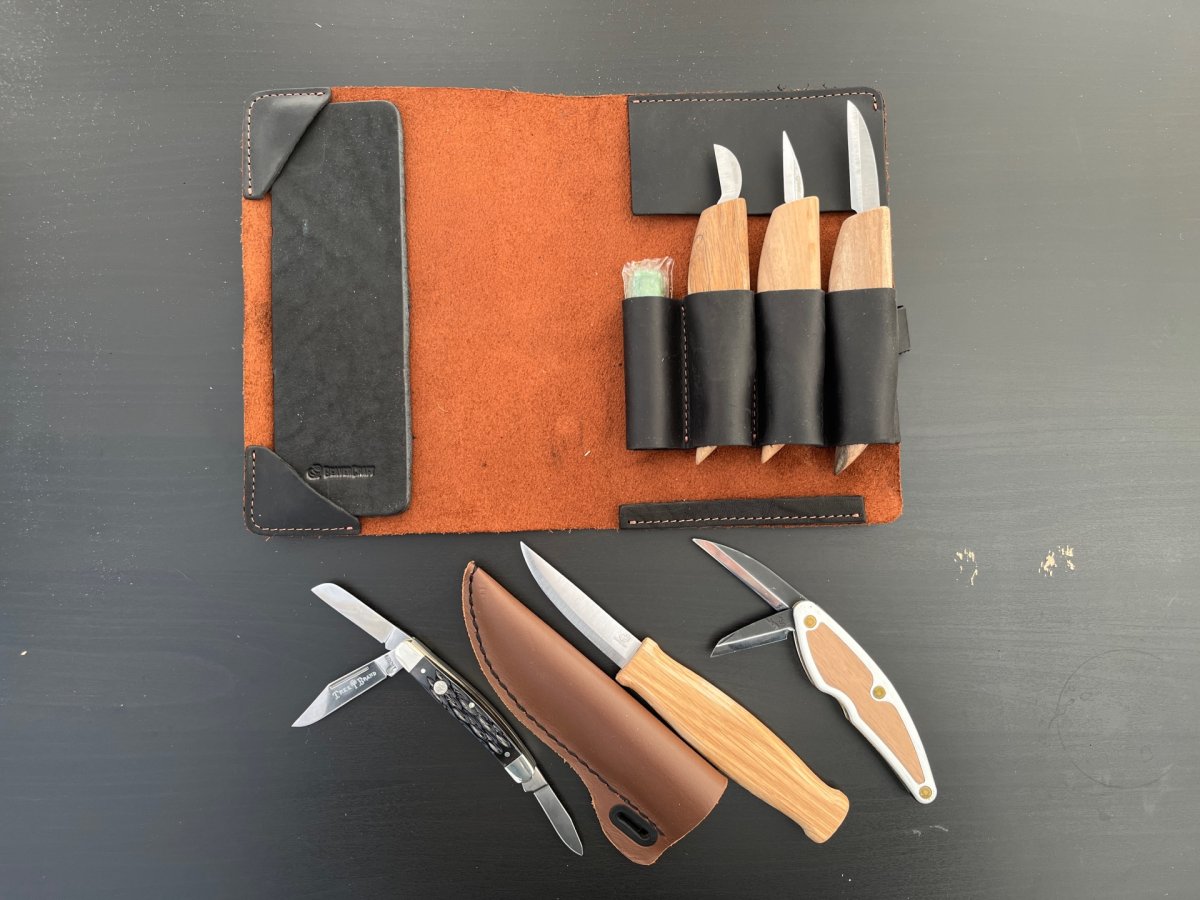
We may earn revenue from the products available on this page and participate in affiliate programs. Learn More ›
Whittling differs from wood carving in that whittlers perform their craft solely with wood and a good whittling knife, while wood carvers employ chisels, gouges, and occasionally power tools to shape the wood. The simplicity of whittling allows just about anyone to pick up a relatively inexpensive whittling knife and a piece of wood and get started.
A new whittling knife is always an exciting addition for new and experienced craftsmen alike. You get to try out the cut of a new blade and the grip of the handle. Ideally, the right whittling knife will sit comfortably in your hand and have a curve to the blade to enhance your whittling ability. We’ve scoured customer reviews and spent 12 hours testing a few highly regarded models in order to find the best whittling knife. Our favorite was the BeaverCraft S15X Wood Carving Set. Because project conditions vary, we really liked that the kit included 3 rugged knives for different cutting needs, and they felt as good in our hands after 3 hours of whittling as they did at first.
But your needs and preferences may vary, so be sure to check out our reviews of the other knives we tested. Whether you need a folding knife to carry in your pocket, a larger knife for working with greenwood, or even a gift idea, this guide has you covered. Our product evaluations and shopping considerations are here to help you find the best whittling knife for your next project.
- BEST OVERALL: BeaverCraft S15X – Premium Wood-Carving Set
↓ Jump to Review - BEST BANG FOR THE BUCK: BeaverCraft C4S – Whittling Knife with Leather Sheath
↓ Jump to Review - BEST PORTABLE: Flexcut JKN88 Whittlin’ Jack Carving Knife
↓ Jump to Review - BEST POCKET KNIFE: Böker TS 2.0 Medium Stockman Pocket Knife
↓ Jump to Review - BEST FOR GREENWOOD: Morakniv 120 Wood-Carving Knife
↓ Jump to Review - BEST FOR DETAILING: BeaverCraft C15 – Detail Wood-Carving Knife
↓ Jump to Review - BEST SET: Elemental Tools 9-Piece Wood-Carving Tools Set
↓ Jump to Review - BEST POCKET-SIZE:Opinel No. 8 Carbon Steel Folding Knife
↓ Jump to Review
| BeaverCraft Wood Carving Set | BeaverCraft Wood Carving Knife | Flexcut Whittlin’ Jack | Böker Medium Stockman | Morakniv Wood Carving Knife | BeaverCraft Detail Carving Knife | Elemental Tools Wood Carving Tools Set | Opinel No. 8 Folding Knife | |
| Knife type(s) | Wood carving, detail carving, chip carving | Sloyd | Wood Carving | General purpose | Wood Carving | Detail carving | Wood carving, sloyd, hook | General purpose |
| Blade length | 2 inches, 1⅖ inches, 1 inch | 2⅞ inches | 2 inches, 1½ inches | 2 inches, 1¾ inches, 1½ inches | 2⅓ inches | 1½ inches | Not provided | 3¼ inches |
| Edge grind type | Scandi | Scandi | Scandi | Flat | Scandi | Scandi | Scandi | Flat |
| Handle material | Black walnut | Oak | Aluminum | Steel and bone | Birch | Ash | Walnut | Beech |
Our Top Picks
Best Overall
BeaverCraft S15X – Premium Wood-Carving Set
What We Like
- Accommodates different whittling styles
- Excellent quality for the price
- Comfortable, easy to control
- Arrived sharp; blades held their edge well
- Kit includes bandages, just in case
What We Don’t Like
- Some users may prefer a single general-purpose knife
Specs
- Knife type(s) Wood carving, detail carving, chip carving
- Blade length 2 inches, 1⅖ inches, 1 inch
- Handle material Black walnut
Our Ratings: Comfort 5/5; Sharpness 5/5; Build Quality 5/5; Value 5/5
If you’re serious about whittling or wood carving, chances are you’ll want a few different blades for roughing in general shapes, fleshing out details, and adding decorative touches. Whether you’re a complete novice or an expert in need of another set of whittling tools, the BeaverCraft Deluxe S15X wood carving kit comes with everything you need: a large wood carving knife, detail carving knife, chip carving knife, polishing compound, leather strop, and genuine leather storage pouch.
Compared to some of the other blades we tested, these were much less flexible. We liked the rigidity, although some users prefer more flexibility. The straight blade edge and downward-curving spine of the 2-inch carving knife gave it a good combination of power and precision that worked well for roughing and general carving. The shorter, narrower detail knife blade was very articulate when it came to narrowly curved cuts and smaller cuts overall.
The BeaverCraft knives came out of the box sharp and ready to work. As we carved, the edge durability proved to be excellent, as well. Working with basswood blanks, we stopped once an hour to hone the blades with good results. The walnut handles felt good in hand and provided excellent blade control. The well-tuned blades and comfortable handles allowed us to intuitively make controlled push cuts and pairing cuts and gradually improve our chip-carving techniques.
What our tester says: “The BeaverCraft whittling knife set looks great in its leather pouch, and cuts just as well. I’ve only whittled with a pocket knife and was amazed by the comfort and control I had with these knives. And the blades stayed very sharp all the way through the test.”—Mark Wolfe, Product Reviews tester and writer
Get the BeaverCraft S15X whittling knives at Amazon, Walmart, or BeaverCraft.
Best Bang for The Buck
BeaverCraft C4S – Whittling Knife With Leather Sheath
What We Like
- Affordable price for a quality knife
- Good design for rough whittling and bigger projects
- Sharp, durable edge
- Includes a leather sheath
What We Don’t Like
- Blade was shorter than advertised
Specs
- Knife type(s) Sloyd
- Blade length 2⅞ inches
- Handle material Oak
Our Ratings: Comfort 5/5; Sharpness 5/5; Build Quality 5/5; Value 5/5
The BeaverCraft C4S is a single-blade knife with a sturdy 2⅞-inch blade. Its shallow belly is ideal for controlling long planing cuts, and the thin tip cleanly negotiates short curved cuts. The knife has a handle just under 5 inches long that’s made of solid oak and treated with natural linseed oil to protect the wood from moisture, rot, and decay. The handle is smooth and comfortable in the hand, and it boasts an ergonomic design intended for long periods of use. Perhaps best of all is its budget-friendly price, which may be a surprise for this level of quality.
The high-carbon steel blade is somewhat susceptible to rust, so you’ll need to keep it clean, and properly stored after every use. It retains an edge for a long time while working with just about any type of hardwood or softwood. The blade comes presharpened so you don’t have to worry about grabbing your sharpening stone or leather strop before you can start whittling. Once you are done, store it safely in the included leather sheath until you want it again.
We used the BeaverCraft sloyd knife to shape carving blanks out of dried poplar that we split from a pile of firewood. The wood was dry and hard, but this knife was the tool for the job. It sliced smoothly and produced long, curled shavings. After an hour, we honed the blade and worked at it for another hour. The handle felt good, the blade kept its edge, and our hands felt great after whittling for two hours.
Get the BeaverCraft C4S whittling knife at Amazon or BeaverCraft.
Best Portable
Flexcut JKN88 Whittlin’ Jack Carving Knife
What We Like
- Sturdy yet lightweight
- Ergonomic handle and blade design
- Sharp, durable edges
- Includes blades for roughing and details
What We Don’t Like
- Thin handle profile is more tiring with extended use
Specs
- Knife type(s) Folding roughing knife and detail knife
- Blade length 2 inches, 1½ inches
- Handle material Aluminum inlaid with wood veneer
Our Ratings: Comfort 4/5; Sharpness 5/5; Build Quality 5/5; Value 4.7/5
The Flexcut Whittlin’ Jack is ideal for whittlers who want a trusty whittling knife that can fit in their pocket. It features a 1½-inch detail knife blade and a 2-inch roughing knife blade, both of which fold into a durable aluminum handle inlaid with wood veneer. The blades are made of high-carbon steel for easy sharpening and extended edge retention. The knife comes presharpened so that you can get to work as soon as it arrives.
The Whittling Jack is only 4 inches long when folded, so it can easily fit in a pocket or bag. The handle has a curved ergonomic shape for effortless control during use. We were able to use it as effectively as traditional wood-handled carving knives—with the exception of certain push cuts. Since the blades on this knife do not lock, we had to be more careful when pushing on the spine of the blade to avoid accidentally closing the knife. It was a minor concern, but one that stayed in the back of our minds throughout the test.
Our project results with this knife were excellent. Both blades maintained keen edges for an hour of whittling at a time. The blade angle and handle shape made control easy and mostly comfortable, but after two hours of cutting, we noted more hand fatigue than we experienced with the traditional handle designs.
What our tester says: “Using the Flexcut Whittlin’ Jack felt very much like other high-quality whittling knives. The angle between the blade and the handle felt comfortably familiar. I was able to control the cuts just as well as with a fixed blade. I can’t imagine a better design.”—Mark Wolfe, Product Reviews tester and writer
Get the FlexCut whittling knife at Amazon, Woodcraft, Lee Valley, or Flexcut.
Best Pocket Knife
Böker TS 2.0 Medium Stockman Pocket Knife
What We Like
- Beautiful traditional pocket knife
- D2 steel blades for excellent edge retention
- Assortment of blades for different cutting needs
- General-purpose knife for everyday carry
What We Don’t Like
- Blades are not purpose-designed for whittling
- Smaller handle offers less comfort and control
Specs
- Knife type(s) Folding multipurpose knife (clip, sheepsfoot, and spey blades)
- Blade length 2⅛ inches, 1¾ inches, 1½ inches
- Handle material Nickel silver bolsters, brass linings, bone scales
Our Ratings: Comfort 4/5; Sharpness 5/5; Build Quality 5/5; Value 4.7/5
If you don’t necessarily plan to dive deeply into this hobby, it can make a lot of sense to whittle with a pocket knife. The Böker Stockman is a tried-and-true design with a good assortment of blades. It measures 3 inches long closed, and the blades are made of D2 tool steel for optimum edge retention. This knife is both durable and stylish, with nickel silver bolsters, black jigged bone scales, and brass linings. In keeping with the traditional stockman pattern, it comes with a 2-inch clip blade, a 1¾-inch sheepsfoot blade, and a 1½-inch spey blade.
The Böker pocket knife came with nicely sharpened blades, but we honed them with a few strokes on the 3,000-grit stone and strop to bring the blades to the same level of sharpness as the other knives in the test. Surprisingly, this was the only knife we tested that did not require honing after the first hour of whittling. Once sharp, it stayed quite sharp for a long time.
Whittling with a pocket knife is more nostalgic than efficient, but it is effective and very accessible. Roughing and basic detail carving were doable, but the smallish handle and comparatively blunt-tipped blades made it more challenging to refine the work. Still, this was the easiest knife to carry in a pocket and whittle on a whim, which is perfect for carving details on a hiking stick while resting beside a scenic vista, or making basic three-dimensional figures while sitting around the campfire. For those with larger hands, the Böker Large Stockman might be a better fit.
Get the Böker whittling knife at Amazon, Swiss Knife Shop, Knife Country USA, or Böker USA.
More Great Options
Choosing the right whittling knife is as much about personal comfort and whittling style as it is about blade designs or handle shapes. If the knives we tested are not quite right for you, consider the following options, all of which have received rave reviews from dedicated whittlers and wood carvers.
Best For Greenwood
Morakniv 120 Wood-Carving 120 Knife
What We Like
- Multipurpose blade for carving greenwood
- Slightly curved blade
- Full tang, laminated steel blade
- Premium oiled birch handle
What We Don’t Like
- Less effective for figure carving and fine details
Specs
- Knife type(s) Wood carving knife
- Blade length 2⅓ inches
- Handle material Birch
First-time whittlers or woodworkers on a budget might hesitate to invest much money in a new whittling knife, but the Morakniv 120 is an affordable option, providing you with a single laminated steel whittling knife with a 2.35-inch blade. The laminated steel has a high-carbon steel core to help the blade hold its edge, but softer alloy steel surrounds the core to reduce the weight of the knife and to increase rust and corrosion resistance.
The sloyd-style tapered blade with slightly up-curved tip gives this knife the balance of power and precision required for rough carving greenwood from the forest. It’s slightly less effective for working with kiln-dried wood from the lumber yard or hobby store.
The handle on the Morakniv is just over 4 inches long and made of oiled birchwood that sits comfortably in the hand. The soft wood is gentle to the touch, but provides a durable grip for precise whittling. This knife comes with a black plastic holder to protect the blade when not in use. The laminated steel blade doesn’t require the same level of maintenance as a carbon steel blade, but the manufacturer recommends washing and drying the blade by hand after every use to ensure the longevity of the knife.
Get the Morakniv whittling knife at Amazon, Ragweed Forge, or Morakniv.
Best For Detailing
BeaverCraft C15 –Detail Wood-Carving Knife
What We Like
- Short and thin tapered blade
- Ergonomic ashwood handle
- Sharp right out of the box
- Great for working with store-bought wood blanks
What We Don’t Like
- Less effective for rough carving large pieces
Specs
- Knife type(s) Detail carving
- Blade length 1⅖ inches
- Handle material Ash
For smaller whittling projects, a good detail carving knife may be the only knife you need. Designed to make small, precise cuts, the BeaverCraft C15 is a fixed-blade knife that removes material slowly compared to carving knives with bigger blades. The handle comes in high-quality, ergonomically shaped ashwood and measures 4½ inches long, providing a smooth, comfortable grip to reduce hand fatigue.
The high-carbon steel blade is short, at just 1⅖ inches, giving new whittlers the control they need to help make narrow and curved cuts with a high level of control. It features a Scandi grind straight cutting edge, which is durable and easy to maintain. The blade is also thin, allowing you to whittle precision details into the wood. This knife comes presharpened so that you can begin whittling as soon as you find a suitable piece of wood.
Get the BeaverCraft whittling knife at Amazon, Walmart, or BeaverCraft.
Best Set
Elemental Tools 9-Piece Wood-Carving Tools Set
What We Like
- Assorted blades for different project types
- Includes a wood spoon blank and essential accessories
- Affordable price
What We Don’t Like
- Few size and material details from the manufacturer
Specs
- Knife type(s) Sloyd, detail carving, hook
- Blade length Not provided
- Handle material Walnut
This 9-piece carving kit from Elemental Tools offers a combination of tools for whittlers at various levels. The set includes three whittling knives, cut-resistant gloves, polishing compound, leather sharpening strop, and a beechwood spoon blank that you can use as soon as you open the set. The beechwood blank is a medium hardness wood, great for beginners who might cut overzealously into softer woods.
The set comes in a bamboo storage box, which helps to protect the high-carbon steel blades of the hook knife, sloyd knife, and detail knife from rust and corrosion. The knives all come with black walnut handles that are smooth to the touch, while containing a robust and durable material. Black walnut is naturally resistant to moisture and decay, so there won’t be concerns about your handles swelling or cracking.
Get the Elemental Tools whittling knives at Amazon, Wood Art Supply, or Elemental Tools.
Best Pocket-Size
Opinel No. 8 Carbon Steel Folding Knife
What We Like
- Folding knife with locking blade
- Large blade for fast material removal
- Carbon steel blade retains a sharp edge
- Lightweight and comfortable beech handle
What We Don’t Like
- Limited to rough whittling
Specs
- Knife type(s) General purpose
- Blade length 3¼ inches
- Handle material Beech
Those who prefer casual whittling with a pocket knife might look to the Opinel Carbon Steel Folding Pocket Knife. It is an ideal size for carrying in a pocket, at just 4.3 inches long with the blade closed. The hard carbon steel blade can cut through either hardwoods or softwoods, though this knife isn’t recommended for fine whittling. The blade is flat, with a gentle curve toward the end, so you can easily work with either the edge or the belly of the blade.
This folding knife comes with a stainless steel blade locking mechanism that can keep the blade in place when the knife is open or closed, so that you don’t have to worry about the blade slipping free. The handle of the knife is made from durable beechwood that feels smooth in the hand and has a curved tang at its end to give you a more secure grip.
Get the Opinel whittling knife at Amazon, Peaceful Valley, or Opinel USA.
Jump to Our Top Picks
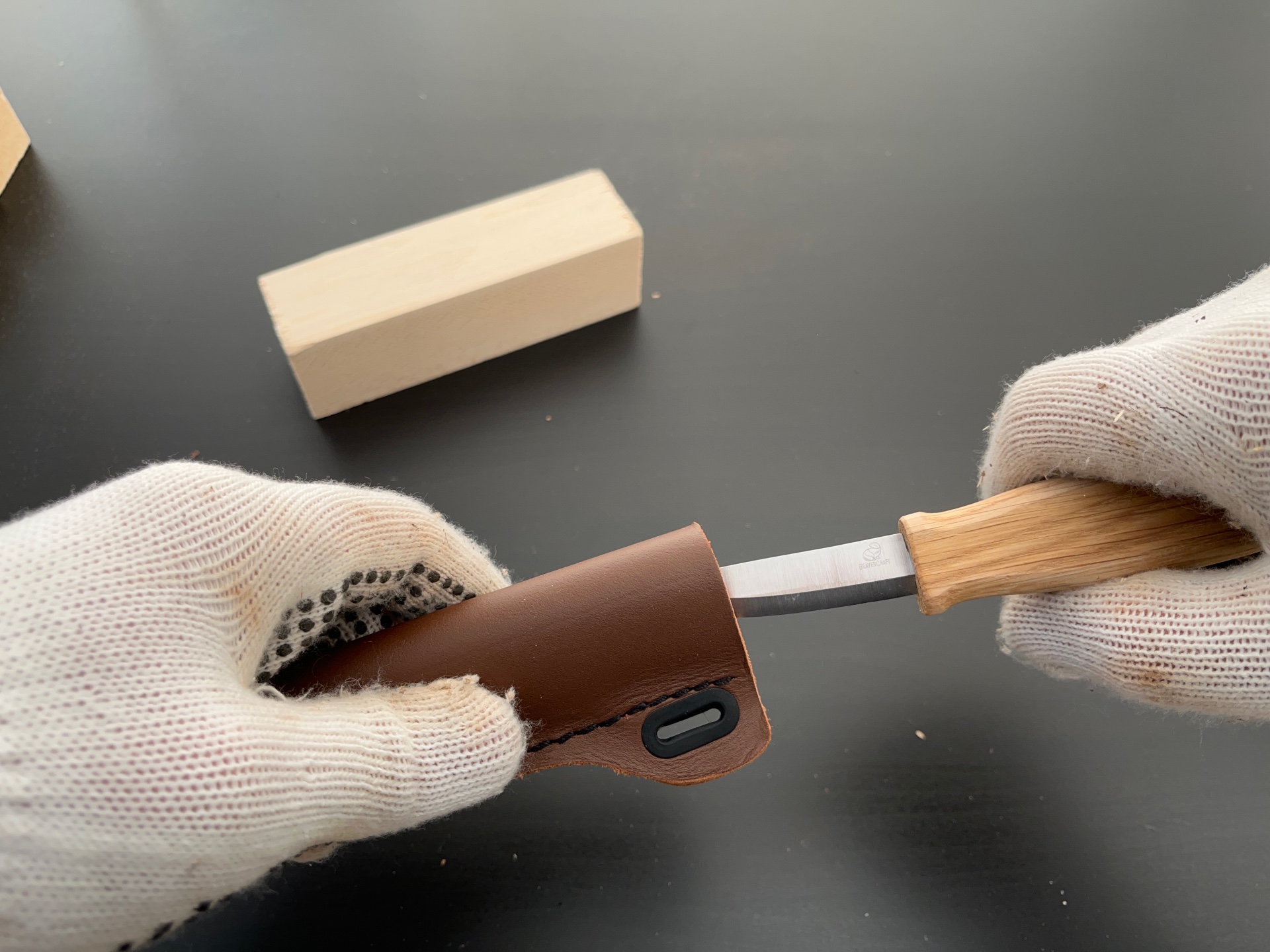
How We Chose and Tested the Best Whittling Knives
Based on our own research and verified customer reviews, we sought a combination of the best quality and most affordable whittling knives for testing. With plenty of options to choose from, we included only the most broadly useful blade types: sloyd, rough carving, detail carving, and chip carving, along with a traditional pocket knife. After analyzing the overall construction of each one, we tested them by whittling for 2 hours each. We noted the initial sharpness, durability of the edge, and how each knife felt in hand with regard to comfort and control. Finally, we scored each one on a rubric before determining the award titles.
| Testing Stats | |
| Products tested | 4 |
| Time spent testing | 12 hours |
| Tests performed | 4 |
| Price range | $20 to $60 |
| BeaverCraft S15X – Premium Wood-Carving Set | BeaverCraft C4S – Whittling Knife | Flexcut JKN88 Whittlin’ Jack | Böker Medium Stockman Pocket Knife | |
| Comfort | 5 | 5 | 4 | 4 |
| Sharpness | 5 | 5 | 5 | 5 |
| Build Quality | 5 | 5 | 5 | 5 |
| Value | 5 | 5 | 4.7 | 4.7 |
What to Consider When Choosing a Whittling Knife
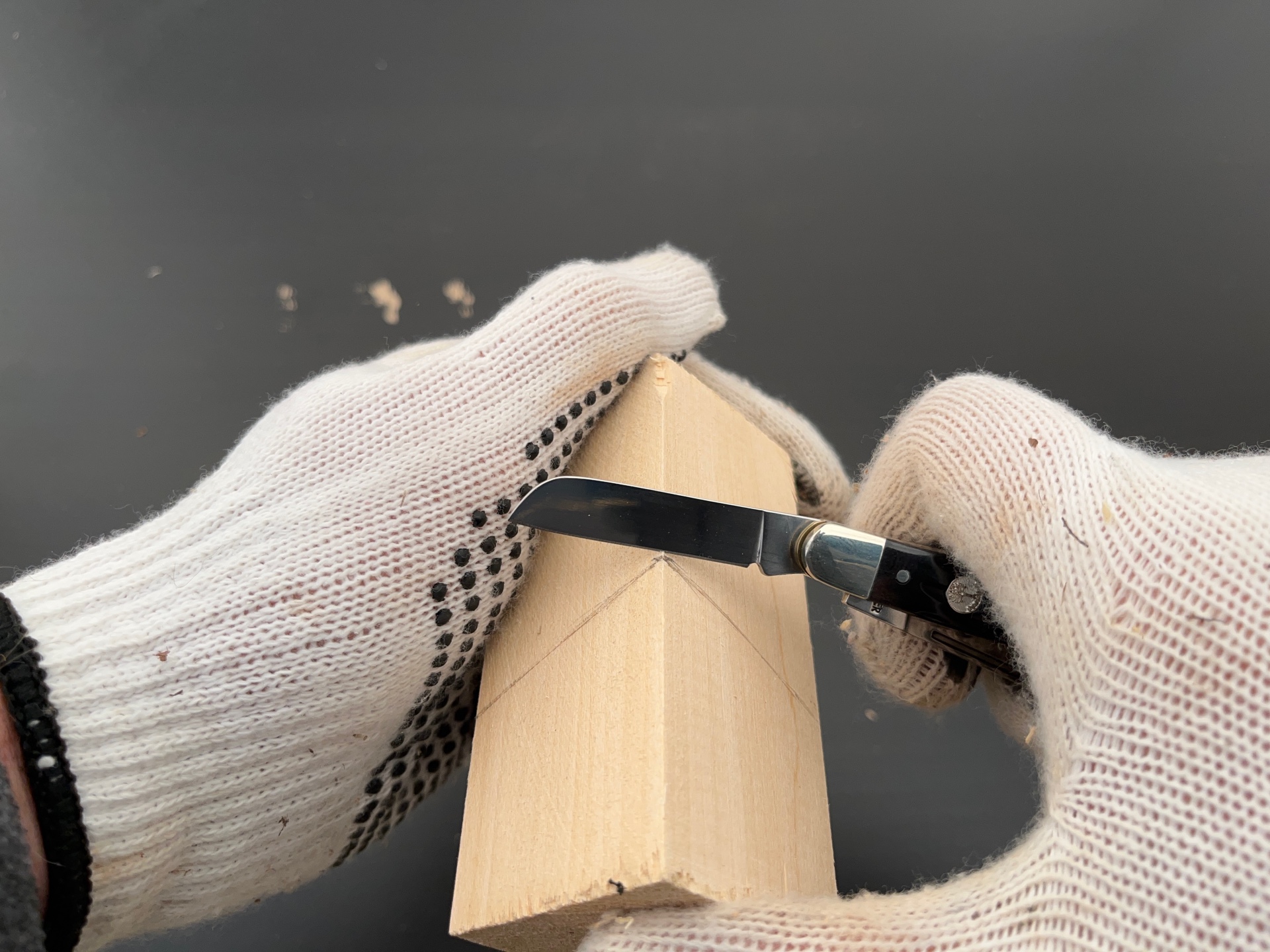
Before choosing a whittling knife, take a few minutes to think about the most important shopping considerations to keep in mind. Determining which type of wood you want to work with, what knife features you’re interested in, and which safety precautions you should focus on will depend on your skill level.
Wood Type
The type of wood you plan to use can influence the whittling knife you select. Beginners might want to start on a stick or piece of wood they find outdoors instead of spending money on precut wood. In this case, a basic whittling knife with no specialty purpose is best to get started.
Once you get the hang of working with a simple stick, you can move on to different types of wood and more advanced whittling knives, such as a hook knife. Intermediate and experienced whittlers will get more value from investing in precut pieces of wood. You can choose from a range of softwoods or hardwoods, though basswood and aspen wood are often used for whittling because of their minimal grain and relatively soft structure.
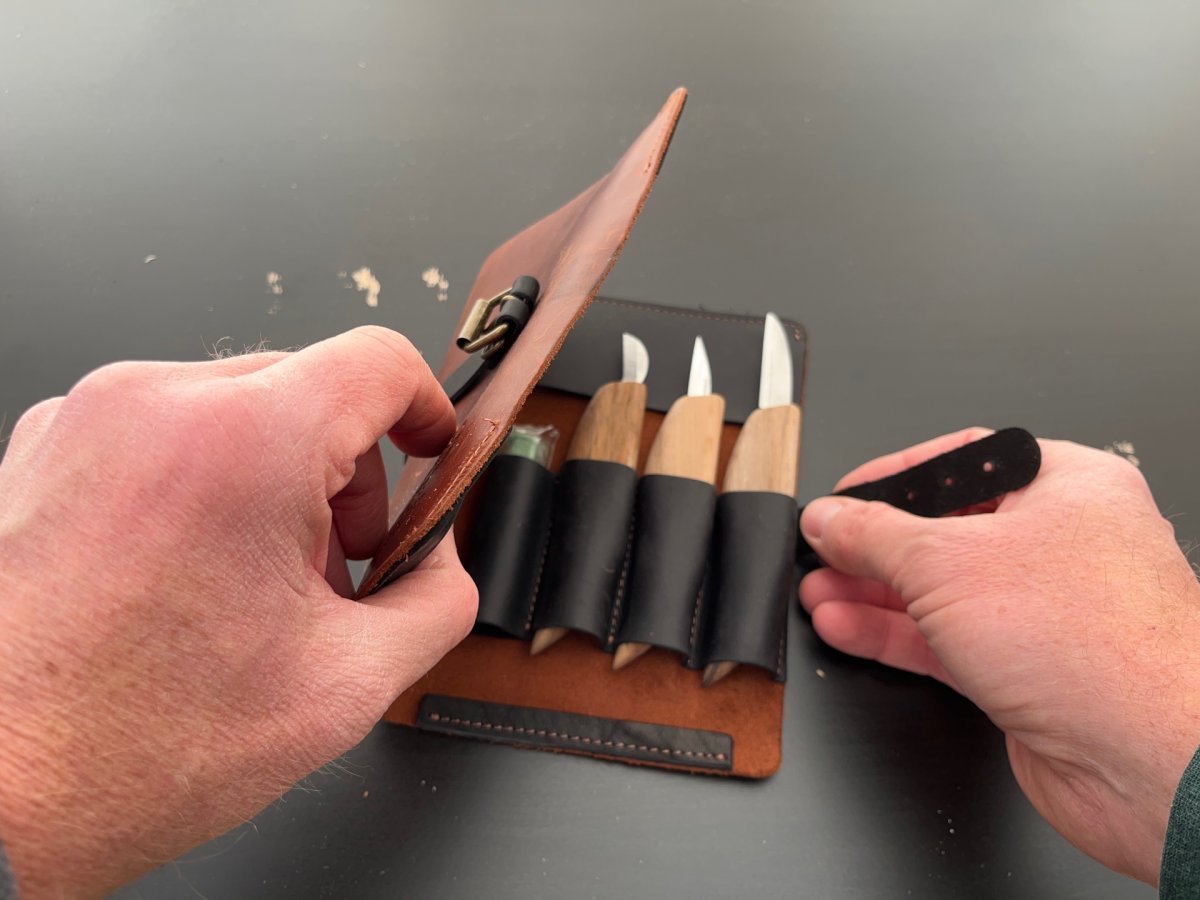
Handle
The blade of a knife is generally considered the most important feature, but the handle greatly affects the balance, weight, and durability of the knife. It is also the part of the knife most responsible for comfort and can contribute to hand fatigue. Whittling knife handles often are made of wood, plastic, or stainless steel.
- Wood is the most commonly used material. It looks classically attractive and provides a smooth, comfortable grip. On the other hand, wood is a porous material that can absorb excess moisture, causing swelling and splitting if the whittler does not care for and store the knife properly. Hardwood handles are less likely to split, but still require maintenance, such as the applying of appropriate oils.
- Plastic is inexpensive, easy to clean, and durable. Though it doesn’t look as nice as wood, you won’t have to worry about splitting or swelling. However, plastic-handled whittling knives can be harder to find.
- Stainless steel is the most durable and easiest to clean of the three choices. Both plastic and wood are more comfortable to hold and manipulate for long periods of time, making stainless steel a poor option for beginner whittlers with inexperienced hand muscles that will likely fatigue quickly with this unyielding handle material.
Blade Material
Whittling knife blades are mostly stainless steel and carbon steel, though some blades are made out of laminated steel.
- Stainless steel blades are a rust-resistant alternative to carbon steel. While stainless steel does not keep an edge as long as carbon steel or laminated steel, it costs less and doesn’t require as much maintenance.
- Carbon steel blades are the most common type of whittling knife blade. They keep a sharp edge with minimal sharpening, which is ideal for working with hardwoods. However, the blades require consistent maintenance and proper storage to ensure that they do not become rusted, frail, and essentially useless.
- Laminated steel blades are made by layering different types of steel during the forging process. This gives them a sharper, longer-lasting edge than stainless steel blades and more rust and corrosion resistance than carbon steel blades.
Blade Shape
The shape of the blade is an important factor to consider. Some blades, like hook blades, are designed for a specific function, but for most projects, blade shape is more a matter of personal preference.
If you are a beginner, you likely want to start with a long, thin blade that doesn’t have much of a belly. (The belly is the rounded portion toward the end of the blade.) Although many beginners prefer a shorter blade for better control and safety, this also can restrict your ability to make certain cuts. If you aren’t sure, it is best to have both a knife with a shorter blade and a knife with a longer blade so that you don’t limit your whittling.
Whittlers should generally avoid any knife blades more than 15 millimeters thick. A blade this thick is obstructive to your cuts and can prevent you from achieving the results you want out of your whittling project.
Blade Locking
Some whittling knives have one or more blades that can fold into the handle when not in use. This protects the blade from damage and makes the entire knife more compact and portable. However, there is a chance that a foldable knife without a blade-locking feature can open up, causing injury if it is in your pocket, or exposing the blade to damage if it opens in your tool box.
If you’re going to get a whittling knife with a foldable blade, it’s a good idea to get one with blade locking. Not all foldable whittling knives will have this option, but safety is a worthy investment.
Single vs. Multi-Blade
Whittling knives can come in a single-blade or multi-blade format, and the latter has to be a foldable knife.
- Single-blade whittling knives are easier to use and often come with a durable handle and sturdy construction that lets you get the most out of the blade. Keep in mind that if you want a fixed-blade whittling knife, you’ll need a single-blade knife, because only these blades offer the choice between a fixed blade or a foldable blade. However, you will have to get a second knife if you want a different blade shape or length.
- Multi-blade whittling knives tend to be less durable and comfortable than single-blade knives because the handle must be large enough to house two or more blades without damaging the cutting edges. The more blades or tools a knife has, the less effective the individual blade tends to be, because it is more likely to attach further from the center of the handle, where it would normally have the most control and cutting power. The obvious benefit of a multi-blade knife is that you get multiple blade types in a single tool. This can be highly effective without much drawback if the knife has only two or three blades.
FAQs
To tackle your next whittling project with as much information as possible, scout these answers to common whittling knife questions.
All you really need to do to whittle wood is pick up a whittling knife and a piece of wood. The wood can be a high-quality block from your local hardware store, or it can be as basic as a piece of a tree branch. Take the knife and begin whittling away pieces of wood until you can form something that somewhat resembles the idea you had in mind.
Whittling is an inexpensive hobby to get started in, and you don’t need any experience. However, you should wear gloves, go slow, and protect your hands at all times to prevent cutting up your fingers—especially the pad of your thumb, which often takes the brunt of slips and nicks during whittling.
There are many ways to sharpen a whittling knife, but the most common method employs a sharpening stone. Lay the blade of the knife flat on the stone, then angle it just slightly while pushing the knife away from you, as though you were trying to cut a piece off of the sharpening stone. Alternately, you can lay the blade flat on the stone with a slight angle, then sharpen the knife by applying pressure to the blade and moving the knife in a small circular motion against the stone.
You can absolutely use a pocket knife for whittling. Some pocket knives even have multiple blades that you can use to create a variety of cuts on your whittling project.
Wood carving is much more involved than whittling. It typically involves the use of chisels and gouges, and one might even use mallets or power tools to carve the wood. Whittling, on the other hand, is performed entirely with a whittling knife.
The Scandinavian grind (also known as the “Scandi grind”), is popular because it offers a keen edge like a flat grind blade but with a stronger spine for added durability.
Most whittling knife blades are short, typically measuring less than 2 inches in length. But the handles are chunky and curved for an easy grip and blade control.
Whittling wears on the blade, but the sharpening process is minimal. For best results, most whittlers strop the blade once every hour or so. Use a leather strop with polishing or stropping compound.
Depending on the knife and what feels right to you, a good carving knife for wood will have a 15- to 20-degree edge bevel.
Meet the Tester
Mark Wolfe is a writer and product tester with a background in the green industry. He’s also an avid DIYer who lives in an older home. When he isn’t writing, he spends his time upgrading, repairing, and replacing anything and everything in his home, yard, and garden. He tests and writes reviews about tools, lawn care and home repair products, and outdoor living goods.
Additional research provided by Timothy Dale.
